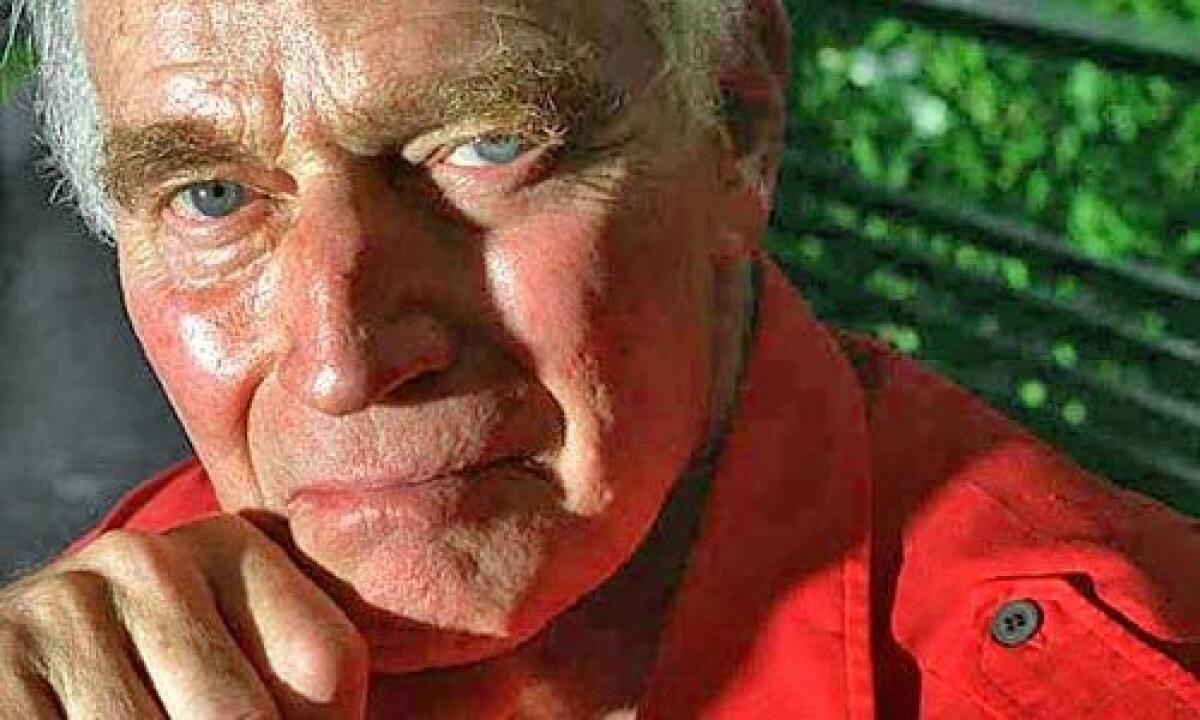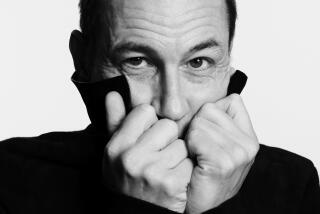Charlton Heston, 84; actor, Oscar winner, played grand figures

- Share via
Charlton Heston, the Oscar-winning actor who achieved stardom playing larger-than-life figures including Moses, Michelangelo and Andrew Jackson and went on to become an unapologetic gun advocate and darling of conservative causes, has died. He was 84.
Heston died Saturday at his Beverly Hills home, said family spokesman Bill Powers. In 2002, he had been diagnosed with symptoms similar to those of Alzheimer’s disease.
FOR THE RECORD:
Heston obituary: The obituary of Charlton Heston in the April 6 A section reported that Yakima Canutt directed the chariot race scene in the film “Ben-Hur,” and a subsequent correction said Andrew Marton was the director. Both men were second-unit directors on the film, according to the on-screen credits and the Directors Guild of America. According to the American Film Institute Catalog of Feature Films, “Contemporary information . . . and modern interviews suggest that, while Marton was responsible for the overall staging and shooting of the sequence, Canutt was responsible for coordinating the actors, stuntmen, horses and chariots for the race itself.” —
With a booming baritone voice, the tall, ruggedly handsome actor delivered his signature role as the prophet Moses in Cecil B. DeMille’s 1956 Biblical extravaganza “The Ten Commandments,” raising a rod over his head as God miraculously parts the Red Sea.
Heston won the Academy Award for best actor in another religious blockbuster in 1959’s “Ben-Hur,” racing four white horses at top speed in one of the cinema’s legendary action sequences: the 15-minute chariot race in which his character, a proud and noble Jew, competes against his childhood Roman friend.
Heston stunned the entertainment world in August 2002 when he made a poignant and moving videotaped address announcing his illness.
Late in life, Heston’s stature as a political firebrand overshadowed his acting. He became demonized by gun-control advocates and liberal Hollywood when he became president of the National Rifle Assn. in 1998.
Heston answered his critics in a now-famous pose that mimicked Moses’ parting of the Red Sea. But instead of a rod, Heston raised a flintlock over his head and challenged his detractors to pry the rifle “from my cold, dead hands.”
Like the chariot race and the bearded prophet Moses, Heston will be best remembered for several indelible cinematic moments: playing a deadly game of cat and mouse with Orson Welles in the oil fields in “Touch of Evil,” his rant at the end of “Planet of the Apes” when he sees the destruction of the Statue of Liberty, his discovery that “Soylent Green is people!” in the sci-fi hit “Soylent Green” and the dead Spanish hero on his steed in “El Cid.”
The New Yorker’s film critic Pauline Kael, in her review of 1968’s “Planet of the Apes,” wrote: “All this wouldn’t be so forceful or so funny if it weren’t for the use of Charlton Heston in the [leading] role. With his perfect, lean-hipped, powerful body, Heston is a god-like hero; built for strength, he is an archetype of what makes Americans win. He represents American power -- and he has the profile of an eagle.”
For decades, the 6-foot-2 Heston was a towering figure in the world of movies, television and the stage.
“He was the screen hero of the 1950s and 1960s, a proven stayer in epics, and a pleasing combination of piercing blue eyes and tanned beefcake,” David Thomson wrote in his book “The New Biographical Dictionary of Film.”
Heston also was blessed by working with legendary directors such as DeMille in “The Greatest Show on Earth” and again in “The Ten Commandments,” Welles in “Touch of Evil,” Sam Peckinpah in “Major Dundee,” William Wyler in “The Big Country” and “Ben-Hur,” George Stevens in “The Greatest Story Ever Told,” Franklin Schaffner in “The War Lord” and “Planet of the Apes” and Anthony Mann in “El Cid.”
“Four or five of those men would be on anybody’s all-time great list,” Heston said in a 1983 interview. “And if I picked up one scrap, one piece of business, from each of them, then today I would be a hell of a director.”
John Charles Carter was born Oct. 4, 1923, in Evanston, Ill. His father, Russell Whitford Carter, moved the family to St. Helen, Mich., where Heston lived an almost idyllic boyhood, hunting and fishing.
He entered Northwestern University’s School of Speech in 1941 on a scholarship from the drama club. While there, he fell in love with a young speech student named Lydia Clarke. They were married March 14, 1944, after he had enlisted in the Army Air Forces. Their union was one of the most durable in Hollywood, lasting 64 years in a town known for its highly publicized divorces, romances and remarriages.
Theatrical name choice
After the war, he went on countless auditions as a stage actor in New York. His professional name was a combination of his mother’s maiden name, Charlton, and the last name of his stepfather, Chester Heston.
He made his Broadway debut opposite legendary stage actress Katharine Cornell in Shakespeare’s “Antony and Cleopatra” as Proculeius, Caesar’s aide-de-camp.
Heston found steady employment in the new medium of television. His big break occurred in 1949, when he appeared in the CBS live “Studio One” production of Shakespeare’s “Julius Caesar.”
In 1949, he attracted the attention of veteran film producer Hal Wallis. Without an audition, Wallis signed Heston to an independent contract for five pictures with the option he could accept other roles.
Heston’s first picture for Wallis was the 1950 film noir “Dark City” opposite femme fatale Lizabeth Scott. He played a troubled World War II veteran, and the film did respectable business.
But it was his chance meeting on the Paramount Pictures lot with DeMille that propelled Heston to stardom. The role that the flamboyant director wanted him for was the rugged circus manager in the 1952 big-top spectacular, “The Greatest Show on Earth,” which won the Academy Award for best picture.
Over the next three years, Heston made 11 movies, playing Buffalo Bill Cody in “Pony Express” and Andrew Jackson in “The President’s Lady.”
Then DeMille entered his life again, casting Heston as Moses in “The Ten Commandments.”
“My choice was strikingly confirmed,” DeMille wrote, “when I had a sketch made of Charlton Heston in a white beard and happened to set it beside a photograph of Michelangelo’s famous statue of Moses. The resemblance was amazing; and it was not merely an external likeness.”
He wasn’t the only Heston in the film. His baby son, Fraser, made his screen debut as the infant Moses who is carried downstream in a basket.
“The Ten Commandments,” a blockbuster hit, was followed by “Touch of Evil” and “The Big Country.”
Then came “Ben-Hur.”
Ironically, though it was arguably Heston’s most famous role, and the only one that earned him an Oscar, he was not the first actor considered. Burt Lancaster, Paul Newman and Rock Hudson were under consideration for the role of heroic Judah Ben-Hur.
The film’s breathtaking chariot race, directed by legendary stuntman Yakima Canutt, took five weeks to film and required 15,000 extras.
The film went on to win 11 Oscars, including best picture and best director for Wyler.
Playing larger-than-life heroes seemed to carry over into real-life politics for Heston. He was one of the major Hollywood stars who marched with the Rev. Martin Luther King Jr. during the civil rights era.
But Heston’s politics soon veered right and he became an admirer of conservative Sen. Barry Goldwater of Arizona, who was the Republican Party nominee for president in 1964.
“My politics haven’t changed -- it was the Democratic Party that changed,” the actor said.
Always a political animal, Heston relished his role as a lightning rod for criticism over his passionate defense of gun ownership. He once told the Times of London, “In this country, if someone breaks into your house, you can shoot them. And I would do that in a second if my wife were back there sleeping and someone broke in.”
In 1998, with his acting career waning, Heston became president of the National Rifle Assn. and instantly became one of the more politically polarizing figures in America.
During his five-year reign as NRA president, Heston vowed to push the group “back into the mainstream” of American politics.
His name was so synonymous with the defense of guns and gun owners that Michael Moore sought him out for an interview in his 2002 Academy Award-winning documentary “Bowling for Columbine.” But the aging Heston walked out of the on-screen interview as Moore peppered him with probing questions about the nation’s gun use, and the usually unflappable actor seemed angry and flustered.
Heston was not afraid of taking on entertainment corporations such as the giant Time Warner, which in 1992 came under scrutiny for releasing rapper Ice-T’s controversial CD “Cop Killer.” Heston, who owned several hundred shares of Time Warner stock, stood up at the stockholders’ meeting in Beverly Hills and read every profane lyric in that song as well as another explicit cut from the rap album.
Though his film work occupied most of his career, he never abandoned his theatrical roots. He was a mainstay for years on stage, especially at the Ahmanson Theatre in Los Angeles, tackling everything from Eugene O’Neill’s “Long Day’s Journey into Night,” Robert Bolt’s “A Man for All Seasons” and “Macbeth” with co-star Vanessa Redgrave.
Although Heston had fond memories of working with Welles, Wyler and DeMille, he didn’t always get along with filmmakers, especially the scrappy, hard-living Sam Peckinpah, who directed him in the 1965 intense western “Major Dundee.”
As Heston recalled it in his autobiography, the actor took umbrage after Peckinpah changed directions and swore at the actor for disobeying his command. Heston drew his saber and rode full-speed at the director, who leaped aside only moments before the sword-wielding actor galloped past him.
“I can’t believe I would have actually ridden Sam down, let alone sabered him,” Heston wrote. “But I was as angry as I can remember being in my life.” Heston would call “Major Dundee” a “disappointing” film.
After “Ben-Hur,” Heston had an uneven film career. In the 1960s, he continued to play historical characters in lavish epics such as Michelangelo in “The Agony and the Ecstasy” and Gen. Charles “Chinese” Gordon in “Khartoum.” But none of them were as successful critically as “Ben-Hur.”
Then, in 1968, he appeared in two roles vastly different from what his fans were accustomed to -- one that brought him box office success and the other critical kudos.
Heston brought a quiet strength and dignity to his role as an aging cowpoke in the character-driven western “Will Penny,” directed by Tom Gries. Though the film wasn’t a commercial success, reviewers admired his understated turn. Leonard Maltin called it one of the best films on the cowboy-loner ever to come out of Hollywood.
But Heston scored his biggest post-”Ben-Hur” success with his first foray into science fiction, playing a no-nonsense, heroic astronaut whose space capsule crashes on a planet ruled by intelligent, English-speaking apes and where humans were treated like chattel. Although he had often shown his buffed physique on screen, “Planet” marked the first time he appeared in a nude scene.
Though many of his films in the 1970s did well at the box office, like the sci-fi thriller “Soylent Green” and the nail-biters “Airport ‘75” and “Earthquake,” the reviews were abysmal.
Return to television
The 1980s marked his return to television, starring in ABC’s “The Colbys,” the short-lived spinoff of the prime-time soap opera “Dynasty,” and several TV movies and miniseries.
Despite his granite-jawed, Moses-like image, Heston was not above poking fun at himself. In the twilight of his career, he was a jovial two-time host of “Saturday Night Live,” and had a cameo as “the good actor” in “Wayne’s World 2,” and even appeared as himself in a 1998 episode of the hit NBC sitcom “Friends.”
Although his days as the leading man were over, he worked steadily in small but interesting roles, including the one-eyed CIA director in James Cameron’s “True Lies,” the Player King in Kenneth Branagh’s “Hamlet,” a high-powered football commissioner in Oliver Stone’s “On Any Sunday” and an uncredited appearance in ape attire in Tim Burton’s 2001 remake of “Planet of the Apes.”
Throughout his life, Heston was active in various areas of the entertainment industry. Besides serving as president of the Screen Actors Guild, he also was chairman of the American Film Institute, head of President Reagan’s Task Force on the Arts and Humanities, and involved in several charities. President Lyndon B. Johnson appointed him to the Council on the Arts, the executive body controlling grants made by the National Endowment for the Arts.
In addition to his Oscar, Heston received numerous U.S. and international awards and honors, among them the Hollywood Foreign Press Assn.’s Cecil B. DeMille Award, the Screen Actors Guild Life Achievement Award, the Academy of Motion Picture Arts and Sciences’ Jean Hersholt Humanitarian Award and the Kennedy Center Honors Lifetime Achievement Award. In 2003, he was awarded a Presidential Medal of Freedom by President George W. Bush.
In later years, Heston battled physical ailments. In 1996, he underwent hip replacement surgery and two years later he was treated for prostate cancer. In 2000, he revealed in the National Enquirer tabloid that he had entered a rehab clinic for a drinking problem.
In addition to his wife and son, Heston is survived by a daughter, Holly Heston Rochell; and three grandchildren.
Services will be private. His family has requested that, in lieu of flowers, donations be made to the Motion Picture and Television Fund, 22212 Ventura Boulevard, Suite 300, Woodland Hills, CA 91364. Details: www.mptvfund.org.
King is a Times staff writer; Welkos is a former Times staff writer.
More to Read
Start your day right
Sign up for Essential California for the L.A. Times biggest news, features and recommendations in your inbox six days a week.
You may occasionally receive promotional content from the Los Angeles Times.







